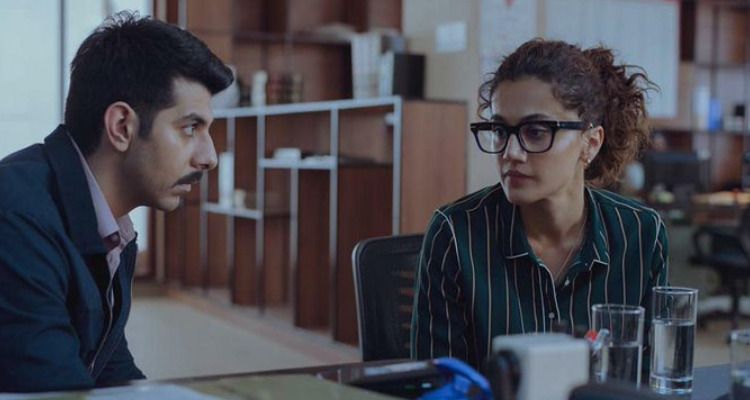LIFF 2022: Do Baaraa

Originally published on 18/08/22 for the UCL Film & TV Society's Journal
“Gangs of Wasseypur has been my greatest undoing”
This was Anurag Kashyap’s response to being asked about the film at a Q&A held after the premiere of his latest film, Do Baara (or alternatively, Dobaaraa, since the title is polysemous- it refers to either the time 2:12 or the word “again”) at the opening gala of the London Indian Film Festival. In the context of the Q&A, Kashyap mourned the effect of his massively successful crime duology on his career, since its near-universal acclaim from both international and Indian audiences for diverging from the model of commercial success for mainstream Hindi cinema led to the expectation that every Kashyap directorial feature following it would be more of the same. The director’s description of the film as a vice enclosing his desire to experiment as an artist is all the more significant in the context of Do Baaraa, since it marks perhaps the least bombastic film in Kashyap’s oeuvre. Absent is the provocativeness of Raman Raghav 2.0, or the period textures of Black Friday and Bombay Velvet. Here, Kashyap uses the skeletal structure of the genre film as a platform to explore millennial inertia and yearning, situating his characters in spaces both genuine and distorted, where their desires and aspirations collide with not only those of others but with the far-reaching tendrils of spacetime itself-to mixed effects.
Revolving around Taapsee Pannu’s steel-nerved surgeon Nandini, the film presents the classic time travel parable as something literalized- what if everything you wished were different about your life did change? As a consequence of moving to Pune in the midst of a crumbling marriage, the strains on her relationship with her husband, a hotel manager, are intensified, which is reflected in the nigh-perpetual geomagnetic storm clouding the film’s skies (which is also one of the many consequences of Kashyap’s tendency to leave little to the imagination). Simultaneously, another timeline runs in parallel- that of a 9-year old boy, Anay, in 1996, who lived in the same house as Nandini. His untimely death at the hands (or bumper, to be precise) of a firetruck acts as the lynchpin blending both continuums into one. The MacGuffin of a CRT television acts as a literal and figurative gateway between the two timelines, allowing cross-continuum communication. Thus, time travel is framed as a distinctly postmodern narrative instrument, in that it is impossible to separate it from hallmarks of the genre like The Terminator (which also acts as a conduit for Anay to wrap his head around the events of the film). The potential for pastiche is therefore evident, but its precise narrative construction prevents it from indulging in it entirely until its denouement, at which point it collapses.
Part of what reinforces the notion that Kashyap at least partly relies on pastiche here is the film’s textures- or to be precise, the lack of any discernable textural qualities. The unmistakable Netflix sheen casts a long shadow over the film, coating its exteriors in a dull palette of greys and blues (though one could posit that this is representative of Late Style filmmaking). Thus, when Kashyap stages elaborate tableaus of deception, there is an absence of tangible dimension to the entities onscreen, making it difficult to conjure any genuine sense of danger. To his credit, however, Kashyap’s direction renders several unremarkable images compelling in relation to each other. One sequence follows Anay through a house occupied by an alleged murderer, searching for clues to confirm his suspicions that something sinister is afoot; here, Kashyap effectively situates us in the position of a child confronted by horrors of the adult world that they can’t even begin to wrap their heads around. This tension is rendered even tauter when it becomes evident that the supposed murderer is still in the house. Anay’s attempts to make his presence unknown lead to him ducking under tables and hiding behind doors, with the murderer always one step away. It is in these sequences where Kashyap’s concerns with violence brimming underneath the everyday are most evident, and it is where the film’s spatialisation of memory takes on a tangible quality. Even the spectre of the Netflix sheen is held at bay via the staging of sequences where obfuscation, (not unlike Scott’s Déjà Vu) in the form of frosted glass and elaborate blocking, guides the film’s visual expression of its thematic concerns with positionality. Moreover, the way in which the film explores the state of time displacement as a form of existential schizophrenia relies upon recontextualizing images that seemed otherwise innocuous in the original timeline as totally alien in the new timeline, thus casting Nandini as a tragic figure.
Acting as the film’s moral and narrative centre is Nandini, who infuses the time-travelling crime caper with a remarkably lived-in presence. Her attempts to wrestle with suddenly finding herself in a world where she has achieved everything she ever aspired to, but at the expense of her life as a mother, appeals to a universal melancholy. She is at once able to induce sorrow and laughter, often without even a tonal shift in the scene itself. Upon awakening within the alternate timeline, one of the first things she does is seek out her husband to try and make sense of her life being upended quite literally overnight. Following a Keatonesque sequence in which she tries to prove her identity (to comical effect) for the staff of the hotel her husband manages, she barges into a boardroom, confronting her husband as if having yet another domestic argument. It is only when he demands that she be removed from the grounds of the hotel that, in his incredulousness, she realizes that he truly has no idea who she is. This triggers a desperation to seek a way to return to her timeline, which is contrasted by frequent cuts to Anay in 1996; just as she discovers less and less through becoming alienated from her previous life, Anay discovers more and more about the sinister undercurrent running below harmonious domestic facades. This narrative symbiosis between the two undergoes a reversal in the film’s third act, where (without divulging too much of the utterly absurd yet glaringly obvious twist) Anay is no longer vulnerable and where Taapsee is no longer searching for answers.
However, the third act is also where the film’s rather effective emotional oscillations are overcome by Kashyap’s tendencies, as both a director and a screenwriter, to rely on hollow subversion and shock value. Of course, shock value is not inherently detrimental, but in a context where this narrative subversion is telegraphed with all the subtlety of a vuvuzela practically screaming out the answer to Nandini’s questions, it weighs down what would have otherwise been a poignant epilogue. Her journey ends all too easily, bow-wrapped with Mobius strips of cosmic coincidence. Though Do Baaraa does not end in idyll- in fact, an acceptance of sacrificing an “ideal” life in pursuit of closure is what Nandini’s narrative arc builds towards- it does not end on a note of finality either, rendering its denouement an attempt to end the film both all too soon and all too late. Perhaps it was a result of Kashyap (as he professed in the Q&A following the film) accepting Taapsee’s pitch for the film in a state of intoxication, or perhaps it was simply an exhaustion of ideas- either way, in its attempt to subvert the conventions of the time travel film, Do Baaraa fails to construct either narrative threads or images compelling enough to actually deconstruct.
